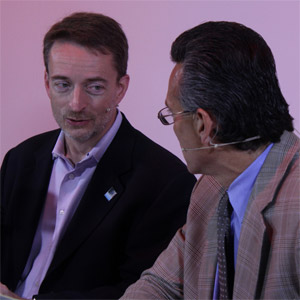 NEWS
NEWS
 NEWS
NEWS
 NEWS
NEWS
![]() Pat Gelsinger, President and Chief Operating Officer of EMC, dropped into theCube at EMC World 2012 to speak with John Furrier and Dave Vellante—he visits every year at EMC World and always brings a lot of interesting insights into the moving-and-shaking projects at EMC. This time he sat down with the intrepid pair to talk about the future of the market, flash storage, and even analytics.
Pat Gelsinger, President and Chief Operating Officer of EMC, dropped into theCube at EMC World 2012 to speak with John Furrier and Dave Vellante—he visits every year at EMC World and always brings a lot of interesting insights into the moving-and-shaking projects at EMC. This time he sat down with the intrepid pair to talk about the future of the market, flash storage, and even analytics.
Vellante mentioned that EMC’s portfolio has transformed across the board with acquisitions, Isilon, flash, and software.
“Clearly with the acquisition of XtremIO, as we understand the taxonomy of the industry today, we have all the pieces we need,” said Gelsinger. “But far be it for me to say that we’ve ended innovation in this space at that level. So, I’ll never say never: we haven’t cornered the market on new innovative ideas but at least we understand the taxonomy now. We got the pieces we need, period.”
He went on to explain how all the products that EMC has gathered tie together in a synergy that deliver not just fabric, connectivity, storage, and analytics, but also the availability to mean that all EMC products are extensions of each other. A customer can grab ahold of one product and then look around the portfolio and discover that if they want to upgrade sideways or expand their project, there it is already in EMC’s inventory and it fits right in for them.
Furrier asked Gelsinger to speak about “frictionless data movement” and what’s called data viscosity or otherwise and understanding of how much analysis and business methodology is tied up in not just access but being capable of making sure data is where it is when it’s needed. Gelsinger sees the metaphor as a “data pool” instead of a data island, how private silos are a thing of the past, and that what’s important is virtualizing the data.
Now people don’t just need to store that data, but they need to store it with context and they need to be able to protect it. All of these elements mean that the raw data is just as important as the metadata attached to it as well as the application path for moving it from place to place or accessing it for analysis. All of these elements come together with EMC products in not just providing storage for massive amounts of data but rapid, protected availability.
EMC as a disruptive player in the data center infrastructure market
“What is it? We view our vision as centering around three things: cloud, big data, on a foundation of trust…” says Gelsinger. “And we see those things becoming the foundations for data and IT of the future. It is being the most disruptive player for data center infrastructure writ large.”
He sees EMC as wanting to be the primary data center infrastructure provider for everyone from big to small, enterprise IT, and even on-the-ground solutions.
“We are a products and technology company, 17,000 engineers,” he continues, “and we’re going to keep growing our engineering capacity. We’re going to increase our percent R&D over time.”
EMC has been huge in acquisitions and successful choices over the past few years. We’ve seen them grow from a storage company into an all-in-one infrastructure company who don’t just provide solutions, but bring together other companies who offer hardware, software, communication, and products that organically blur together.
![]()
Impact on niche communities
Gelsinger says that through all the different markets he saw two that were very ad hoc and extremely unstructured: the university (academic) community and the startup community. So EMC took a hard look at those cultures and started up projects to align to them.
He says that they started platforms that would cater to their needs, workshops to explain how they could use data infrastructure products to aid their missions. While much of both of these cultures work from the basis of people and they also often produce a great deal of data—generally with very low budgets in the beginning looking at academic—meant that it was a good place for EMC to insert themselves into the smaller niche aspects of big data and storage.
Click here for a slideshow of images from the interview
EMC culture and Gelsinger on “being a cool global company”
“In successful companies cultures are never static, you have to keep moving them forward, changing them, evolving them,” says Gelsinger. “I think we really have evolved as a leader and a much cooler place to participate in. As a thought leader in the industry we’re on the leading edge of the cloud, we’re on the leading edge of big data.
“But the next layer of the transformation really about is about being a global company. With all the success we’ve had with expanding the company success globally, I have to be as cool in Beijing, Shanghai, Qingdao, Bangalore, São Paulo, etc. I have to be seen as a cool leader in all of those places as well.
“I think we’ve gone from East Coast to a broad data center play,” he continues, “and the next phase for us is to really be a cool global company.”
THANK YOU